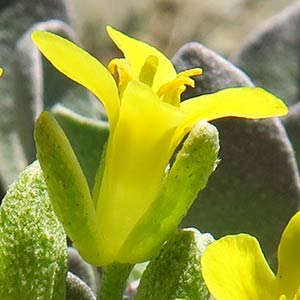|
alpine twin-pod, Washington bladder-pod, Washington twin-pod
|
roundleaf bladderpod
|
| Perennials; caudex usually simple, rarely branched, (cespitose); (silvery) pubescent throughout, trichomes several-rayed, rays (1- or) 2-bifurcate, (low-umbonate, tubercles relatively few, small). |
Perennials; caudex simple or branched, (thickened by persistent leaf bases); densely pubescent (foliage usually scabrous), trichomes (sessile or short-stalked), several-rayed, rays furcate near base, (usually strongly umbonate, roughly tuberculate, less so over umbo). |
several from base, decumbent to ascending, (unbranched), 0.5–1.5 dm. |
few to several from base, erect or outer decumbent, 0.5–2.5 dm. |
(petiole slender); blade obovate, 3–5 cm (width 10–20 mm, base tapering abruptly to petiole), margins entire, (apex rarely slightly acute). |
blade suborbicular to elliptic or ovate or deltate, 0.5–2(–6.5) cm, margins entire or shallowly dentate. |
blade oblanceolate, 0.5–1.5 cm (width 3–5 mm), margins entire. |
(proximal shortly petiolate, distal usually sessile); blade narrowly elliptic or obovate, (0.5–)1–2.5(–4) cm, margins entire. |
subcorymbose. |
compact, (± subumbellate to densely corymbiform, elongated or not). |
sepals oblong, 8–10 mm; petals spatulate, 12–14 mm. |
sepals ± elliptic, 4.5–7(–8.5) mm, (median pair thickened apically); petals (sometimes white), suborbicular to obovate or obdeltate, 6.5–15 mm, (base narrowing to broad claw, apex sometimes emarginated). |
(divaricate, straight), 5–10 mm. |
(usually spreading at right angles, sometimes nearly erect, ± straight), 5–15(–20) mm, (stout). |
didymous, mostly highly inflated (strongly flattened at least in 1/2 toward replum), 14–18 × 14–18 mm, (papery, basal sinus slightly notched, apical open, shallow); valves (retaining seeds after dehiscence), evenly pubescent; replum lanceolate, 7–10 mm, width 1.5–2.5 mm, as wide as or wider than fruit, apex acute to acuminate; ovules 8–10 per ovary; style 5–7 mm. |
(sessile or shortly stipitate, less than 1 mm), subglobose to broadly ellipsoid, inflated or slightly compressed (terete or subterete), (4–)5–8(–9) mm; valves (not retaining seeds after dehiscence), glabrous; replum as wide as or wider than fruit; ovules 8–16 per ovary; style 4–8(–9) mm. |
flattened, (2–3 mm). |
flattened. |
= 48–52, 52, 64, 67–70. |
|
|
|
|
|
| Flowering May–Jun. |
|
| Alpine scree, rocky ridges, talus slopes, volcanic sands and gravel, serpentine gravel, granitic slopes, mountain shrub, subalpine fir, and whitebark pine communities |
|
| (700-)1300-2400 m ((2300-)4300-7900 ft) |
|
|
WA
|
CO; KS; NE; NM; OK; TX
|
|
Subspecies 2 (2 in the flora). (Discussion copyrighted by Flora of North America; reprinted with permission.) |
|
1. Caudices branched (well-developed); petals usually yellow, rarely white, 6.5-12(-14) mm, usually 1.5 times or less as long as sepals; racemes usually not elongated (subumbellate). | subsp. ovalifolia |
1. Caudices usually simple; petals white, (9-)11-15 mm, often 2 times as long as sepals; racemes usually elongated. | subsp. alba |
|
| FNA vol. 7, p. 624. |
FNA vol. 7, p. 655. |
| Brassicaceae > tribe Physarieae > Physaria |
Brassicaceae > tribe Physarieae > Physaria |
P. acutifolia, P. alpina, P. angustifolia, P. arctica, P. arenosa, P. argyraea, P. arizonica, P. aurea, P. bellii, P. brassicoides, P. calcicola, P. calderi, P. carinata, P. chambersii, P. cinerea, P. condensata, P. congesta, P. cordiformis, P. curvipes, P. densiflora, P. didymocarpa, P. dornii, P. douglasii, P. eburniflora, P. engelmannii, P. eriocarpa, P. fendleri, P. filiformis, P. floribunda, P. fremontii, P. garrettii, P. geyeri, P. globosa, P. gooddingii, P. gordonii, P. gracilis, P. grahamii, P. hemiphysaria, P. hitchcockii, P. humilis, P. integrifolia, P. intermedia, P. kingii, P. klausii, P. lata, P. lepidota, P. lesicii, P. lindheimeri, P. ludoviciana, P. macrocarpa, P. mcvaughiana, P. montana, P. multiceps, P. navajoensis, P. nelsonii, P. newberryi, P. obcordata, P. obdeltata, P. occidentalis, P. oregona, P. ovalifolia, P. pachyphylla, P. pallida, P. parviflora, P. parvula, P. pendula, P. pinetorum, P. prostrata, P. pruinosa, P. pulvinata, P. purpurea, P. pycnantha, P. rectipes, P. recurvata, P. reediana, P. rollinsii, P. saximontana, P. scrotiformis, P. sessilis, P. spatulata, P. subumbellata, P. tenella, P. thamnophila, P. tumulosa, P. valida, P. vicina, P. vitulifera |
P. acutifolia, P. alpestris, P. alpina, P. angustifolia, P. arctica, P. arenosa, P. argyraea, P. arizonica, P. aurea, P. bellii, P. brassicoides, P. calcicola, P. calderi, P. carinata, P. chambersii, P. cinerea, P. condensata, P. congesta, P. cordiformis, P. curvipes, P. densiflora, P. didymocarpa, P. dornii, P. douglasii, P. eburniflora, P. engelmannii, P. eriocarpa, P. fendleri, P. filiformis, P. floribunda, P. fremontii, P. garrettii, P. geyeri, P. globosa, P. gooddingii, P. gordonii, P. gracilis, P. grahamii, P. hemiphysaria, P. hitchcockii, P. humilis, P. integrifolia, P. intermedia, P. kingii, P. klausii, P. lata, P. lepidota, P. lesicii, P. lindheimeri, P. ludoviciana, P. macrocarpa, P. mcvaughiana, P. montana, P. multiceps, P. navajoensis, P. nelsonii, P. newberryi, P. obcordata, P. obdeltata, P. occidentalis, P. oregona, P. pachyphylla, P. pallida, P. parviflora, P. parvula, P. pendula, P. pinetorum, P. prostrata, P. pruinosa, P. pulvinata, P. purpurea, P. pycnantha, P. rectipes, P. recurvata, P. reediana, P. rollinsii, P. saximontana, P. scrotiformis, P. sessilis, P. spatulata, P. subumbellata, P. tenella, P. thamnophila, P. tumulosa, P. valida, P. vicina, P. vitulifera |
|
|
| Lesquerella alpestris |
Lesquerella ovalifolia, Lesquerella engelmannii subsp. ovalifolia |
| Suksdorf: W. Amer. Sci. 15: 58. (1906) |
(Rydberg) O’Kane & Al-Shehbaz: Novon 12: 326. (2002) |
| |


